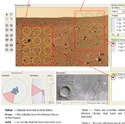CMU MHCI '04
Phase II: Iterative Design
Project Scope
During the summer semester, we generated an interface for the next generation of the Science Activity Planner based on our data from the spring semester. Our scope was to design an application that supports data analysis, activity planning, and constraint editing across all stages of the mission. In order to design the application, we first had to design a science planning process in order to give the application context.
Design Challenges
In addition to addressing the breakdowns we witnessed during the spring semester in the MER process, we had to consider changes in future missions for which SAP would be used, specifically the '09 Mars Science Laboratory mission. This meant the inclusion of several new design challenges:
During the summer semester, we generated an interface for the next generation of the Science Activity Planner based on our data from the spring semester. Our scope was to design an application that supports data analysis, activity planning, and constraint editing across all stages of the mission. In order to design the application, we first had to design a science planning process in order to give the application context.
Design Challenges
In addition to addressing the breakdowns we witnessed during the spring semester in the MER process, we had to consider changes in future missions for which SAP would be used, specifically the '09 Mars Science Laboratory mission. This meant the inclusion of several new design challenges:
-
Support distributed collaboration
-
Support multiple mission stages
- Primary vs. Extended
-
Templatized vs. Non-templatized
-
“Immersive” planning environment
-
Navigation through time and space
-
Visual representation of activities
-
Control visual clutter
-
-
Provide round-trip data tracking
-
Integrate Constraint Editor features
Design Cycles
After we developed the science planning process and teh interface,, we spent
the rest of the summer specifying the components in more detail and testing
the interface with scientists involved with the MER mission at JPL. Based
on our user tests, we iteratively improved the application until we had
a final solution. Here are the design cycles we performed:


